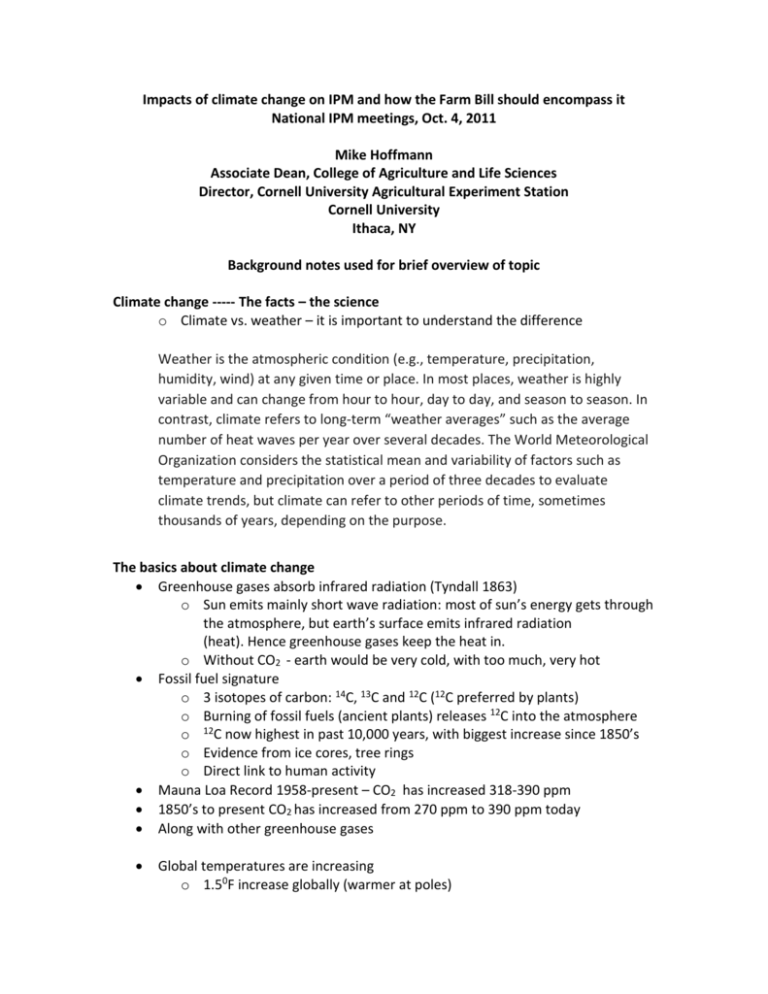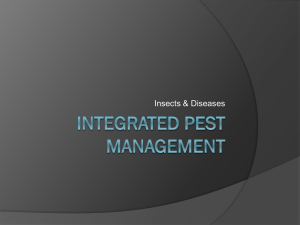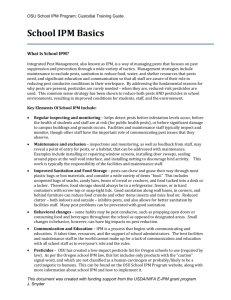Climate Change and IPM - Northeastern IPM Center
advertisement

Impacts of climate change on IPM and how the Farm Bill should encompass it National IPM meetings, Oct. 4, 2011 Mike Hoffmann Associate Dean, College of Agriculture and Life Sciences Director, Cornell University Agricultural Experiment Station Cornell University Ithaca, NY Background notes used for brief overview of topic Climate change ----- The facts – the science o Climate vs. weather – it is important to understand the difference Weather is the atmospheric condition (e.g., temperature, precipitation, humidity, wind) at any given time or place. In most places, weather is highly variable and can change from hour to hour, day to day, and season to season. In contrast, climate refers to long-term “weather averages” such as the average number of heat waves per year over several decades. The World Meteorological Organization considers the statistical mean and variability of factors such as temperature and precipitation over a period of three decades to evaluate climate trends, but climate can refer to other periods of time, sometimes thousands of years, depending on the purpose. The basics about climate change Greenhouse gases absorb infrared radiation (Tyndall 1863) o Sun emits mainly short wave radiation: most of sun’s energy gets through the atmosphere, but earth’s surface emits infrared radiation (heat). Hence greenhouse gases keep the heat in. o Without CO2 - earth would be very cold, with too much, very hot Fossil fuel signature o 3 isotopes of carbon: 14C, 13C and 12C (12C preferred by plants) o Burning of fossil fuels (ancient plants) releases 12C into the atmosphere o 12C now highest in past 10,000 years, with biggest increase since 1850’s o Evidence from ice cores, tree rings o Direct link to human activity Mauna Loa Record 1958-present – CO2 has increased 318-390 ppm 1850’s to present CO2 has increased from 270 ppm to 390 ppm today Along with other greenhouse gases Global temperatures are increasing o 1.50F increase globally (warmer at poles) Alaska 70F, Antarctica 100F Hottest decade ever globally: 2000-2009 Warming very fast (100X faster then since last ice age) o Global average temperatures will increase 8-100F by 2100 (if we continue with business as usual) Temperature data based on 5,000 land based stations, 1000 buoys, ships o Data from satellites – indicates a cooling upper atmosphere and a cooling lower atmosphere, a consistent message And its not just average temperatures o Sea level rise is occurring due to glacial melt, thermal expansion of water (oceans) o Acidification of oceans – 30% increase since late 1800’s o Extreme weather events – more heat, more moisture, events increasing o Glaciers melting - worldwide o Greenland ice – about 50 cubic miles loss/year o Arctic sea ice retreating – artic will be ice free in few decades, well ahead of earlier predictions o Plant hardiness zones moving north o Pines in Rocky’s – 50 -70,000 square miles experiencing death of pines due to extended drought and warmer temperature permitting bark beetle populations to reach extreme densities. • • We face a grand challenge, a different challenge Agriculture will not be business as usual Impacts on IPM o Increasing CO2 levels o Increasing temperatures o Increase in weather variability o Impacts will not be uniform – across US, globe Changes in precipitation patterns o Multitude of direct and indirect impacts on pests, and interactions among pests, natural enemies and crops IPM will not be business as usual Weeds o Weeds generally favored by increasing CO2 levels o Poison Ivy growth greatly accelerated under higher CO2 levels o Increasing temps mean expansion of weeds into higher altitudes, latitudes o Impact on weed control with herbicides - examples Increase in severe weather – heavy rains to droughts Drought can increase cuticle thickness and increased leaf pubescence, thus reduced effectiveness of herbicides Herbicides generally less effective when plants exposed to higher CO2 levels, e.g., glysophate Interactions with herbivores (biological control) agents likely to change Arthropod pests o Increase in CO2 levels results in Increasing Food consumption by larvae (plants may be less nutritious) Reproduction in aphids Predation by some predators Effects of foliar applications of BT – pests eat more leaf area, eat more Bt – increased effect Decreasing Insect developmental rates Response to alarm pheromones by aphids Parasitism Nitrogen based plant defenses o Increase in temperatures General consensus – with warmer temperatures – a great diversity of arthropod pests and higher populations Increased summer temperatures – faster growth, more generations per year, more risk of damage (feeding rates) May in part be countered by faster plant growth? Range expansion –northward, upward range expansion – crop and human pests -- dengue and malaria will likely increase The development of the dengue virus inside the mosquito also shortens with higher temperatures, increasing the proportion of mosquitoes that become infectious at a given time. o Soil conditions – extreme wet to extreme dry will affect stages developing in soil o Biological control - Out of synchrony Hosts emerge first, avoid parasitoids, predators Plant diseases o The plant disease triangle – host, pathogen, environment, will all be affected by increasing temperatures, changes in humidity, CO2 levels o Not simple, some crops become more susceptible, some less susceptible to disease with increasing temperatures o Warmer winters will permit higher levels of survival by some pathogens, and allow northward expansion of some o Warmer and moisture conditions likely to increase incidences of fungal pathogens, leaf wetness will vary more o High or low moisture conditions in the soil – enhance or decrease levels of infection o Increased CO2 levels can increase or decrease severity of plant disease – With higher CO2 growth rates of plants may be faster, closing the canopy sooner – improving conditions for pathogen Higher CO2 can increase levels of fungal spore production Higher CO2 can result in changes in the plant increasing resistance to pathogen o Fungicide efficacy may change with increased levels of CO2, moisture, temperature o Increased incidence of storms may require more applications o Unknown changes in interactions with antagonistic organisms • Impacts on IPM o Greater challenges o More variation in weather, more difficult to predict, more difficult to control pests o Overall more risks – from insects, weeds, pathogens o Use of pesticides more challenging, more frequent rain, higher temperatures o More inputs – pesticides o Reliability of existing threshold levels Because of changes in feeding rates – will today’s insect/plant threshold hold in the future? Reliance on natural enemies may change – out of sync, less benefit from fungal pathogens o Need better communication to producers – with changes in IPM approaches o More multidisciplinary approaches needed o We will need new cultivars, improved irrigation, soil drainage o Major changes in IPM programs o Need increased funding to deal with the combined effects of climate change, but we are seeing cuts at both the state and federal level • Is this an opportunity to stress the importance of IPM? o Need for IPM greater then ever. o More risks to our food security, to human health o But climate change is currently not a high priority in Washington o Will it have a presence in the Farm Bill? References and Additional Reading/Resources Trumble and Butler. 2009. Climate change will exacerbate California's insect pest problems. Cal Ag. 63:73-78 http://ucanr.org/repository/CAO/landingpage.cfm?article=ca.v063n02p73&fulltext=y es See California Agriculture Volume 63, Number 2 “Unequivocal” - How climate change will transform California. http://ucanr.org/repository/CAO/issue.cfm?volume=63&issue=2 Gregory, et al., 2009. Integrating pests and pathogens into the climate change/food security debate. J. Experimental Biology 60:2827-2838. http://jxb.oxfordjournals.org/content/60/10/2827.abstract Wolfe et al., 2008. Projected change in climate thresholds in the Northeastern U.S.: implications for crops, pests, livestock, and farmers. Mitig. Adapt. Strat Glob Change 13:555-575. http://www.springerlink.com/content/r40m6u08772131g2/ See also Overview of climate change impacts on agriculture http://www.climateandfarming.org/clr-cc.php For updates on climate science one option is http://www.climateandfarming.org/clr-cc.php









